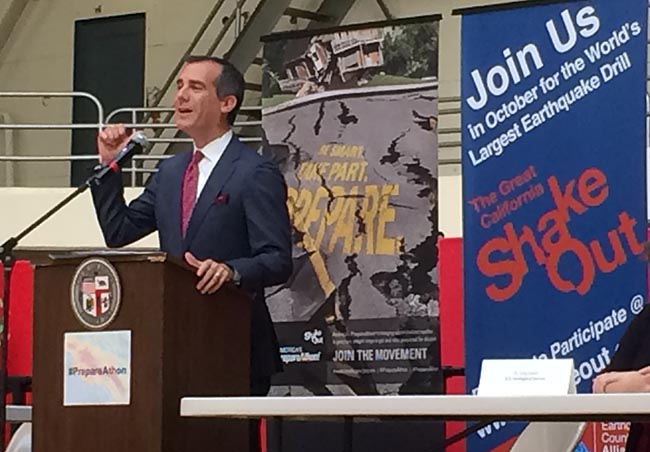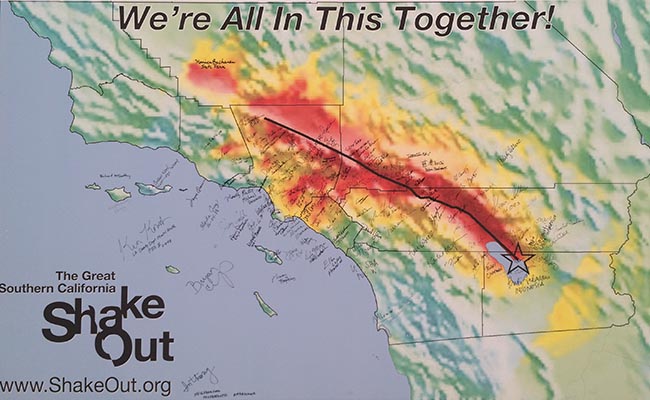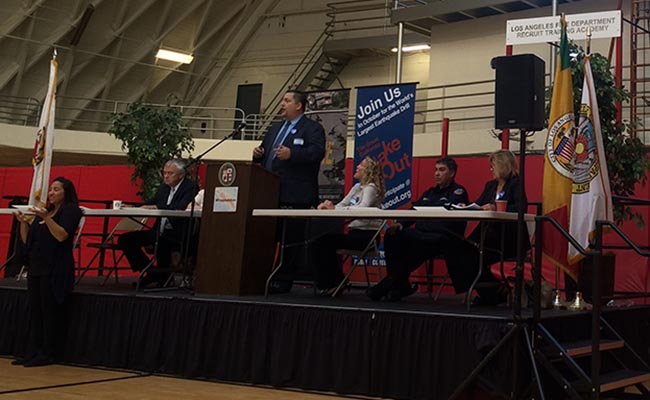When it comes to major earthquake activity in Southern California, the past 20 years has been what U.S. Geological Survey seismologist Dr. Lucy Jones called a “particularly quiet period” that “will not continue.”
As a part of the Sept. 30 National PrepareAthon Day, a campaign aimed at increasing community preparedness and resilience in the event of catastrophic events, The 2015 Great California ShakeOut Breakfast Leadership Summit aimed to shed light on the many faults in the city’s preparedness for the elusive “big one.”
Hoping to shake up communities just enough to get them looking into cementing emergency plans, Jones, whose research is supported by Los Angeles Mayor Eric Garcetti, presented data on potential earthquake damage and introduced possible solutions to help facilitate city-wide resiliency—the ability to recover from an emergency state as quickly as possible.
“Somehow human nature hopes against hope that we can ignore science away,” Garcetti said. “It is a matter of when, not if, we need to be prepared.”
Working with the mayor’s office and using the ShakeOut Earthquake Scenario, Jones and a team were able to prioritize the most important ways in which to create and maintain integrity in the event of a large-scale earthquake: water, telecommunications, and building integrity.
Strengthening each of these three systems in order to quickly recover the city’s economics after sustaining a violent jolting was emphasized.
“What we’re trying to do is keep this system working. But when we have a big earthquake our financial activity is going to drop,” Jones said. “We don’t have electricity, we don’t have water, we’re not opening our buildings.”
Both Jones and Garcetti referenced the demise of San Francisco after the metropolis’ devastating 1906 earthquake. Jones illustrated the city’s dramatic fluctuation in population attributed to the seismic catastrophe.
According to Jones, In 1905, San Francisco was five times larger than Los Angeles. Within a few years, Los Angeles had grown to be larger than the bustling city then known to be the financial center of the West Coast. In a role reversal, Los Angeles has now grown to be five times larger than its Northern California counterpart.
“You can argue that San Francisco never recovered what it lost in that earthquake,” Jones said.

Los Angeles Mayor Eric Garcetti speaks about the role of resiliency in earthquake preparedness Sept. 30.|Marisa Zocco
Garcetti noted the assault of the Southern California 1971 San Fernando and 1994 Northridge temblors on the Los Angeles economy.
“Los Angeles has always been a boom town, except twice,” Garcetti said of the aftermath of the quakes. “We can’t be the city that takes years or decades to get back our strength.”
As it is, L.A.’s sprawling urban environment is interlaced with hundreds of fault lines that are topped with thousands of rickety structures, sheltering millions of people. The rattling reality is that Angelenos are ill-prepared for such catastrophic events like the 7.8 magnitude earthquake used in the Southern California Great Shakeout scenario.
The State’s water supply—which passes through wooden structures, some dating as early as 1908—crosses the San Andreas 31 times. If a large-scale quake devastated the structures, the water supply of not only Los Angeles but much of the state would be compromised.
Of the buildings in Los Angeles, an estimated 300,000, residential and commercial buildings would be rendered uninhabitable or damaged beyond 10 percent of the cost of rebuilding them. Many of the endangered structures are older homes connected to gas lines which sometimes do not include shut off valves.
In a city where old homes lay nearly on top of one another, potentially neighborhood-wide fires could require water for more than quenching the thirst of displaced Angelenos.
“You could have what is called an urban conflagration,” said Mark Benthien, director of communication, education and outreach for the Southern California Earthquake Center. “[One] fire becomes an even bigger fire, with multiple fires that merge together; and that could be a real disaster for the whole region—for the whole country—if we have tens of thousands of homes that catch on fire.”
That’s where the focus areas of telecommunications, water and the state’s building standards become key.
The thought, according to Jones, is that strengthening the telecommunications and cell towers in the region would enable workers unable to enter business buildings to work from home. If water could be shipped in while repairing the state’s pipelines, the working population could possibly remain in the city, pumping breath back into the economy.
Keeping structures in tact to begin with, however, would alleviate a greater number of issues. A step toward sufficient preparedness, according to Jones and Garcetti’s office, would be to mandate retrofitting all the susceptible structures throughout the city.
On Oct. 9, the city unanimously voted to enact what are now the nation’s strictest earthquake safety rules. The new law gives property owners seven years to retrofit wooden structures and 25 years to retrofit concrete buildings.
Still, Jones encouraged making strides to do more than encourage physical survival, but also preserve quality of life.
“I think the steps we are taking are huge. I’m going to say it’s not enough,” Jones said. “We need to get ourselves beyond the mentality that says this is only about dying. This is about living, and about what life will be life after the earthquake.”

















Speak Your Mind